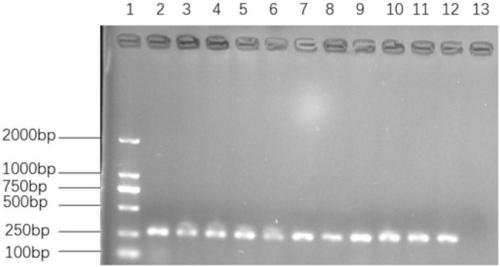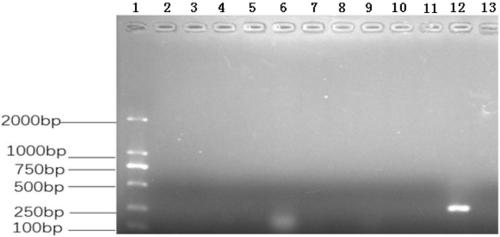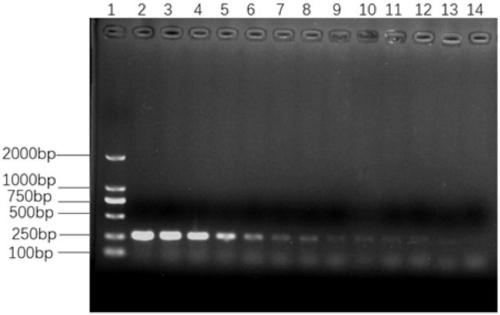Pair of specific primers for detecting Bergeyella, kit and PCR detection method
A detection kit, Bergeyella technology, applied in biochemical equipment and methods, microbial determination/inspection, resistance to vector-borne diseases, etc., can solve the problems of cumbersome, expensive, time-consuming, etc. Effect
- Summary
- Abstract
- Description
- Claims
- Application Information
AI Technical Summary
Problems solved by technology
Method used
Image
Examples
Embodiment 1
[0028] Embodiment 1, the establishment of the PCR detection method of Bergeyella
[0029] 1.1 Primer design
[0030]The present invention downloads Streptococcus, Erysipelas suis, Pasteurella multocida, Salmonella, Haemophilus parasuis, Actinobacillus pleuropneumoniae, Stenotrophomonas maltophilia, and Bergeys suis from the GenBank database , the 16S rRNA gene sequence of Bergeia zoolcers, sequence comparison was carried out by MEGA5.05 software, and the specific sequence of 16S rRNA of Bergeia was found, and then the partial sequence of the 16S rRNA gene of Bergeia D658 bacterial strain in the GenBank database (login No. NR_104718.1) as a reference sequence, select the 170bp-201bp site sequence of the gene fragment as the upstream primer design selection sequence and the 419bp-450bp site sequence as the downstream primer design selection sequence, and use Primer-BLAST design to only amplify Berger Bacteria a pair of specific primers, specifically as follows:
[0031] Upstre...
Embodiment 2
[0044] Embodiment 2, detection method verification
[0045] Utilize the establishment of the Bergeys PCR detection method, 11 strains of Bergeys (its bacterial strains are respectively named as YLD7, SQT1, DC-10, DJ-5, DY-10, DY-8, SQT6, JS2-4, XCSF, ZWSF, FqWF2) were detected, wherein FqWF2 was Bergeia suis, and others were Bergeia zoolis. The results showed that the 11 strains of Bergeyella PCR amplified bands were all 266bp in size, that is, the amplification result was positive ( figure 1 ). It is further illustrated that the established Bergeia PCR detection method can detect isolated and preserved Bergeria.
Embodiment 3
[0046] Embodiment 3, specific detection
[0047] Using Bergeia zoonoticum and 10 common bacteria as detection samples, the established PCR detection method for Bergeia was used for specific detection. The 10 bacteria are Escherichia coli, Salmonella, Proteus, Haemophilus parasuis, Stenotrophomonas maltophilia, Pasteurella, Streptococcus, Erysipelas suis, Actinobacillus pleuropneumoniae, Aeromonas . The results showed that the established PCR detection method for Bergeria was positive for Bergeria animal ulcers, and the other 10 common bacteria were all negative ( figure 2 ). It is further explained that the established PCR detection method for Bergeyella has strong specificity, and only Bergeria is detected as positive, and other non-Bergeytes are detected as negative.
PUM
 Login to View More
Login to View More Abstract
Description
Claims
Application Information
 Login to View More
Login to View More - R&D
- Intellectual Property
- Life Sciences
- Materials
- Tech Scout
- Unparalleled Data Quality
- Higher Quality Content
- 60% Fewer Hallucinations
Browse by: Latest US Patents, China's latest patents, Technical Efficacy Thesaurus, Application Domain, Technology Topic, Popular Technical Reports.
© 2025 PatSnap. All rights reserved.Legal|Privacy policy|Modern Slavery Act Transparency Statement|Sitemap|About US| Contact US: help@patsnap.com



